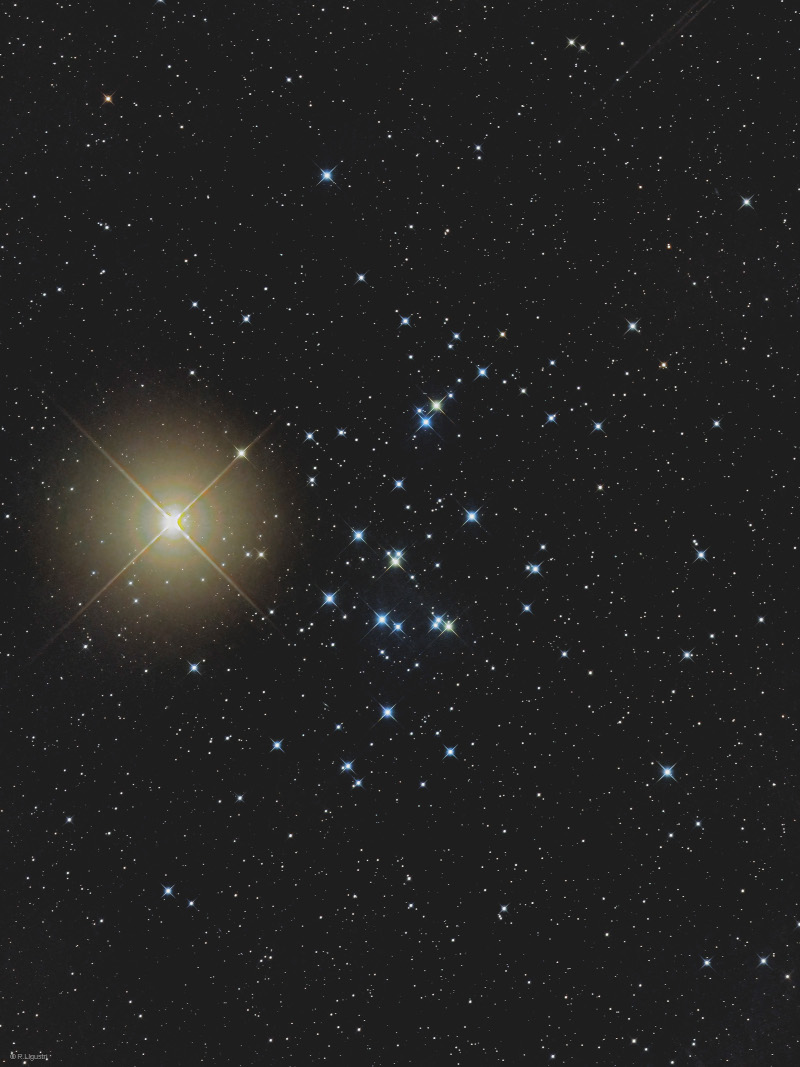10. June 2023
火星 kah 蜂岫星團

探索宇宙1!逐工會揀一幅無仝款 ê 影像抑是相片,𤆬你熟似咱這个迷人 ê 宇宙,閣有專業天文學者2為你3解說4。
- 原始文章:Mars and the Beehive
- 影像來源 kah 版權:Rolando Ligustri
- 台文翻譯:An-Li Tsai (NCU)
[漢羅] 火星 kah 蜂岫星團
這個月,光爍爍 ê 火星 kah 金鑠鑠 ê 金星 攏變做是日落了後 西部天頂上出眾 ê 天體。 火星這粒紅色行星 tī 6 月 3 號 彼陣,行過 巨蟹座。 這張相片就是 火星出現 tiàm 開放星團 Messier 44 附近恆星 ê 時陣 翕著--ê。 這个無偌遠,tī 古早時代就知影 ê 星團,是用目睭就會當直接看著--ê。 伊嘛叫做 鬼宿星團 抑是 蜂岫星團。 蜂岫星團內底 ê 恆星攏比太陽閣較少年,伊 kah 咱 ê 距離才 600 光年遠爾爾。 火星看起來是黃色--ê,才 17 光分遠爾爾。 6 月 12、13 ê 時陣,會換金星 行到蜂岫星團邊仔。 毋過金星傷光矣,按呢蜂岫星團會較歹用目睭直接看著。
[POJ] Hé-chhiⁿ kah Phang-siū-seng-thoân
Chit kò ge̍h, kng-sih-sih ê Hé-chhiⁿ kah kim-siak-siak ê Kim-chhiⁿ lóng piàn-chò sī ji̍t-lo̍h liáu-āu se-pō͘ thiⁿ-téng siōng chhut-chiòng ê thian-thé. Hé-chhiⁿ chit-lia̍p âng-sek kiâⁿ-chhiⁿ tī 6 ge̍h 3 hō hit-chūn, kiâⁿ-kòe Kū-hē-chō. Chit-tiuⁿ siòng-phìⁿ tio̍h-sī Hé-chhiⁿ chhut-hiān tiàm khai-hòng-seng-thoân Messier 44 hù-kīn hêng-chhiⁿ ê sî-chūn hip-tio̍h--ê. Chit-ê bô gōa hn̄g, tī kó͘-chá sî-tāi tō chai-iáⁿ ê seng-thoân, sī iōng ba̍k-chiu tō ē-tàng ti̍t-chiap khòaⁿ--tio̍h--ê. I mā kiò-chòe Kúi-siù-seng-thoân ia̍h-sī Phang-siū-seng-thoân. Phang-siū-seng-thoân lāi-té ê hêng-chhiⁿ lóng pí Thài-iông koh-khah siàu-liân, i kah lán ê kū-lī chiah 600 kng-nî hn̄g niā-niā. Hé-chhiⁿ khòaⁿ--khí-lâi sī n̂g-sek--ê, chiah 17 kng-hun hn̄g niā-niā. 6 ge̍h 12, 13 ê sî-chūn, ē ōaⁿ Kim-chhiⁿ kiâⁿ kàu Phang-siū-seng-thoân piⁿ-á. M̄-koh Kim-chhiⁿ siuⁿ kng ah, án-ne kan-na khò ba̍k-chiu beh ti̍t-chiap khòaⁿ-tio̍h Phang-siū-seng-thoân, sī ū khah khùn-lân
[KIP] Hé-tshinn kah Phang-siū-sing-thuân
Tsit kò ge̍h, kng-sih-sih ê Hé-tshinn kah kim-siak-siak ê Kim-tshinn lóng piàn-tsò sī ji̍t-lo̍h liáu-āu se-pōo thinn-tíng siōng tshut-tsiòng ê thian-thé. Hé-tshinn tsit-lia̍p âng-sik kîann-tshinn tī 6 ge̍h 3 hō hit-tsūn, kiânn-kuè Kū-hē-tsō. Tsit-tiunn siòng-phìnn tio̍h-sī Hé-tshinn tshut-hiān tiàm khai-hòng-sing-thuân Messier 44 hù-kīn hîng-tshinn ê sî-tsūn hip-tio̍h--ê. Tsit-ê bô guā hn̄g, tī kóo-tsá sî-tāi tō tsai-iánn ê sing-thuân, sī iōng ba̍k-tsiu tō ē-tàng ti̍t-tsiap khuànn--tio̍h--ê. I mā kiò-tsuè Kuí-siù-sing-thuân ia̍h-sī Phang-siū-sing-thuân. Phang-siū-sing-thuân lāi-té ê hîng-tshinn lóng pí Thài-iông koh-khah siàu-liân, i kah lán ê kū-lī tsiah 600 kng-nî hn̄g niā-niā. Hé-tshinn khuànn--khí-lâi sī n̂g-sik--ê, tsiah 17 kng-hun hn̄g niā-niā. 6 ge̍h 12, 13 ê sî-tsūn, ē uānn Kim-tshinn kiânn kàu Phang-siū-sing-thuân pinn-á. M̄-koh Kim-tshinn siunn kng ah, án-ne kan-na khò ba̍k-tsiu beh ti̍t-tsiap khuànn-tio̍h Phang-siū-sing-thuân, sī ū khah khùn-lân
[English] Mars and the Beehive
This month, bright Mars and brilliant Venus are the prominent celestial beacons in planet Earth's western skies after sunset. Wandering through the constellation Cancer the Crab, the Red Planet was captured here on the evening of June 3 near the stars of open cluster Messier 44. Recognized since antiquity this nearby, naked-eye star cluster is also known as the Praesepe or the Beehive cluster. A swarm of stars all much younger than the Sun, the Beehive cluster is a mere 600 light-years distant. Seen with a yellowish hue, Mars is about 17 light-minutes away. On June 12/13 Venus will take its turn posing next to the stars of the Beehive cluster. But the dazzling light of Venus will make the Beehive stars difficult to see by eye alone.
詞彙學習
| 漢羅 | POJ | KIP | 華語 | English |
|---|---|---|---|---|
| 火星 | Hé-chhiⁿ | Hé-tshinn | 火星 | Mars |
| 金星 | Kim-chhiⁿ | Kim-tshinn | 金星 | Venus |
| 蜂岫星團 | Phang-siū-seng-thoân | Phang-siū-sing-thuân | 蜂巢星團 | Beehive cluster |
| 開放星團 | khai-hòng-seng-thoân | khai-hòng-sing-thuân | 開放星團 | open cluster |
| 鬼宿星團 | Kúi-siù-seng-thoân | Kuí-siù-sing-thuân | 鬼宿星團 | Praesepe cluster |
| 光年 | kng-nî | kng-nî | 光年 | light-year |
| 光分 | kng-hun | kng-hun | 光分 | light-minute |
| 巨蟹座 | Kū-hē-chō | Kū-hē-tsō | 巨蟹座 | the constellation Cancer |